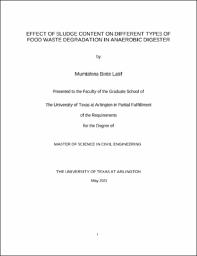| dc.description.abstract | Food waste (FW) is the second-largest component in landfills which impacts environments adversely by generating excessive leachate and greenhouse gas. Generally, conventional anaerobic digester and composting can be used for FW disposal. However, the former is highly expensive while the latter is energy inefficient. In contrast, household or community level underground anaerobic digester offers a cost-efficient solution as well as retrieves valuable energy from FW. The addition of nutrients such as sludge to organic waste especially FW accelerates the production of energy by limiting volatile fatty acid (VFA) accumulation. The objective of the current study is to find out the potential of sludge addition on separate components of FW decomposition and gas generation in lanaerobic digester. This research was conducted by preparing laboratory simulated FW anaerobic digester with four combinations: two pairs of reactors containing meat and grain in addition to the sludge of 20% (MGR1 & MGR2) and 30% (MGR5 & MGR6) respectively as inoculum. Another two pairs of reactors containing fruits and vegetables with the sludge of 20% (FVR3 & FVR4) and 30% (FVR7 & FVR8) respectively. Over the operation period, pH, volume, COD, and VFA tests were conducted for leachate while composition and volume measurements were done for the generated gas. Based on the experimental results, it was found that all the bioreactors showed an extended lag period (> 60 days) before methane generation. Due to decreasing rate of VFA accumulation, FVR3, FVR4, FVR7, and FVR8 presented much better results compared to MGR1, MGR2, MGR5, and MGR6 reactors. However, the lag period for FVR7, FVR8, and FVR3, FVR4 reactors were 75 days and 96 days respectively while MGR1, MGR2, MGR5, and MGR6 were still in lag period. During about 160 days of operation, the average peak methane generation rate for FVR3 and FVR4 was 345 mL/wet-lb./day and 307 mL/wet-lb./day respectively while the cumulative methane generation was 6.8 liters/wet-lb. and 4 liter/wet-lb. respectively. Similarly, the average peak methane generation rate for FVR7 and FVR8 was 182 mL/wet-lb./day and 163 mL/wet-lb./day respectively while the cumulative methane generation was 3.5 liters/wet-lb. and 3.6 liter/wet-lb. respectively. All these reactors FVR3, FVR4, FVR7, and FVR8 were still at the rising stage of the methane generation phase. The percentage of methane found in FVR3, FVR4, FVR7, and FVR8 reactors was 72.5%, 68%, 51%, and 52.1% respectively. However, methane generation from other reactors was found to be negligible; in fact, most of the reactors were still in the initial lag phase. Based on the preliminary results, it is found that the addition of more sludge accelerated the decomposition of fruit and vegetable waste more than the meat and grain waste. Besides, the amount of methane generation was satisfactory for building anaerobic digester. | |


